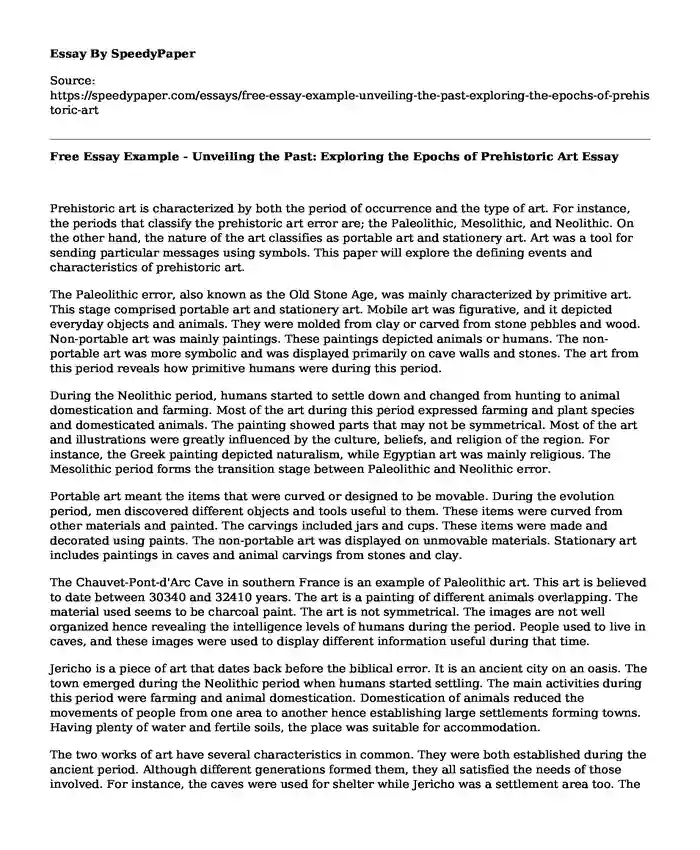Prehistoric art is characterized by both the period of occurrence and the type of art. For instance, the periods that classify the prehistoric art error are; the Paleolithic, Mesolithic, and Neolithic. On the other hand, the nature of the art classifies as portable art and stationery art. Art was a tool for sending particular messages using symbols. This paper will explore the defining events and characteristics of prehistoric art.
The Paleolithic error, also known as the Old Stone Age, was mainly characterized by primitive art. This stage comprised portable art and stationery art. Mobile art was figurative, and it depicted everyday objects and animals. They were molded from clay or carved from stone pebbles and wood. Non-portable art was mainly paintings. These paintings depicted animals or humans. The non-portable art was more symbolic and was displayed primarily on cave walls and stones. The art from this period reveals how primitive humans were during this period.
During the Neolithic period, humans started to settle down and changed from hunting to animal domestication and farming. Most of the art during this period expressed farming and plant species and domesticated animals. The painting showed parts that may not be symmetrical. Most of the art and illustrations were greatly influenced by the culture, beliefs, and religion of the region. For instance, the Greek painting depicted naturalism, while Egyptian art was mainly religious. The Mesolithic period forms the transition stage between Paleolithic and Neolithic error.
Portable art meant the items that were curved or designed to be movable. During the evolution period, men discovered different objects and tools useful to them. These items were curved from other materials and painted. The carvings included jars and cups. These items were made and decorated using paints. The non-portable art was displayed on unmovable materials. Stationary art includes paintings in caves and animal carvings from stones and clay.
The Chauvet-Pont-d'Arc Cave in southern France is an example of Paleolithic art. This art is believed to date between 30340 and 32410 years. The art is a painting of different animals overlapping. The material used seems to be charcoal paint. The art is not symmetrical. The images are not well organized hence revealing the intelligence levels of humans during the period. People used to live in caves, and these images were used to display different information useful during that time.
Jericho is a piece of art that dates back before the biblical error. It is an ancient city on an oasis. The town emerged during the Neolithic period when humans started settling. The main activities during this period were farming and animal domestication. Domestication of animals reduced the movements of people from one area to another hence establishing large settlements forming towns. Having plenty of water and fertile soils, the place was suitable for accommodation.
The two works of art have several characteristics in common. They were both established during the ancient period. Although different generations formed them, they all satisfied the needs of those involved. For instance, the caves were used for shelter while Jericho was a settlement area too. The architect used to form the town was well informed of the needs of the people while the same applied to the paintings that portrayed certain symbols useful to the ancient people.
Conclusion
In conclusion, most of the art during the Paleolithic period was in the form of paintings, while those of the Neolithic period were carvings. The carvings during the Old Stone Age were less precise compared to those emerging during the Neolithic period. Art can be portable, which is movable, or stationary, which is mostly painting and building and stone carvings.
Works Cited
“Prehistoric Art of the Stone Age Types, Characteristics, Chronology.” Prehistoric Art: Origins, Types, Characteristics, Chronology, www.visual-arts-cork.com/prehistoric-art.htm.
Dr Beth Harris and Dr Steven Zucker, et al. "Paleolithic Art, an Introduction." Smarthistory, 8 June, 2018, smarthistory.org/paleolithic-art-an-introduction/.
German, Dr Senta, and Dr Senta German. "Jericho." Smarthistory, 8 Aug. 2015, smarthistory.org/jericho/.
Cite this page
Free Essay Example - Unveiling the Past: Exploring the Epochs of Prehistoric Art. (2024, Jan 07). Retrieved from https://speedypaper.com/essays/free-essay-example-unveiling-the-past-exploring-the-epochs-of-prehistoric-art
Request Removal
If you are the original author of this essay and no longer wish to have it published on the SpeedyPaper website, please click below to request its removal:
- Paper Sample with a Graphic Design Personal Statement
- Free Essay Sample on Public Realm in Urban Design
- Elvis Presley: Biography Essay Example
- Free essay sample: The American Music
- Essay Example - Humans/ Post-Modernism/ Philip Glass
- Free Essay - Japanese Children's Drawings
- Paper Example: Theatre - A Doll's House
Popular categories





